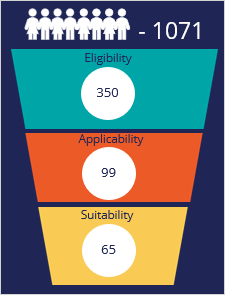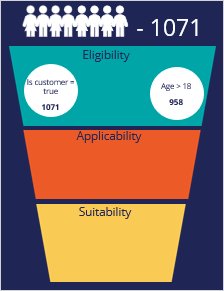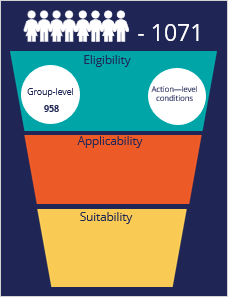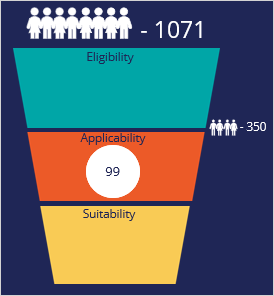
Audience simulation
You can improve the performance of your next-best-action strategy by testing the configuration of engagement policies against a set of customers. In this way, you can check how many potential actions are filtered out by each component of the policy and discover if a particular criterion is too broad or too narrow for your requirements.
Video
Transcript
This video explains what an audience simulation is and how it improves the performance of your Next-Best-Action strategy.
Audience simulation tests the configuration of engagement policies against a set of customers.
Consider an example in which an audience comprises 1071 customers. Let’s see how the audience will be filtered based on the engagement policies.
When the eligibility conditions are applied, only 350 out of 1071 pass through. These 350 customers become the input for the next stage, applicability conditions. Only 99 of the 350 pass through the second stage. In the final stage, suitability conditions, only 65 pass through. Of the original 350, only 65 customers qualify to receive at least one offer.
The filtering that happens in this simulation is similar to a funnel filtration for every engagement policy condition type. However, within an engagement policy condition type, each of the criterion is applied separately to the corresponding input audience.
Let’s now look at the same example in detail to see how the funnel filtration happens within each engagement policy type.
The engagement policies can be defined for a specific group within an issue and/or for individual actions. Group-level conditions are applicable to all the actions within that group while the action-level conditions are applied to that specific action only.
In this case, the total number of the customers in the audience is 1071. Within the eligibility criteria, the first condition does not filter any customers, as all qualify. When the second condition is applied, 958 customers pass through.
Since both conditions need to be met, the intersection of these two conditions, 958, is the final number of customers who pass through at the group level. Now the system checks for individual action-level eligibility conditions that also need to be met.
The intersection of the group-level and action-level conditions form the final eligibility-level output population of 350.
The output population of the eligibility level is passed on as the input for the next level.
The input population that will be filtered by the applicability conditions is therefore 350. When the applicability condition is applied, 99 of the 350 customers qualify for at least one offer. In this case, let’s assume there are no action-level conditions. Thus, the result from the individual group-level condition is the same as the overall applicability level, 99.
The output population of the applicability level, 99 customers, is passed on as the input to the suitability level.
When the suitability group-level condition is applied, 71 of the 99 customers qualify for the offers.
Now the system checks for individual action-level suitability conditions, and the intersection of both group-level and action-level conditions forms the final suitability-level output population, which is 65.
In summary, with the audience simulation test you can check how many potential actions are filtered out by each component of the engagement policy and discover if a particular criterion is too broad or too narrow for your requirements.
This Topic is available in the following Modules:
- Configuring and running simulation tests v1
- Testing engagement policy conditions using audience simulation v1
- Testing engagement policy conditions using audience simulation v2
- Testing engagement policy conditions using audience simulation v3
- Testing engagement policy conditions using audience simulation v4
If you are having problems with your training, please review the Pega Academy Support FAQs.
Want to help us improve this content?






